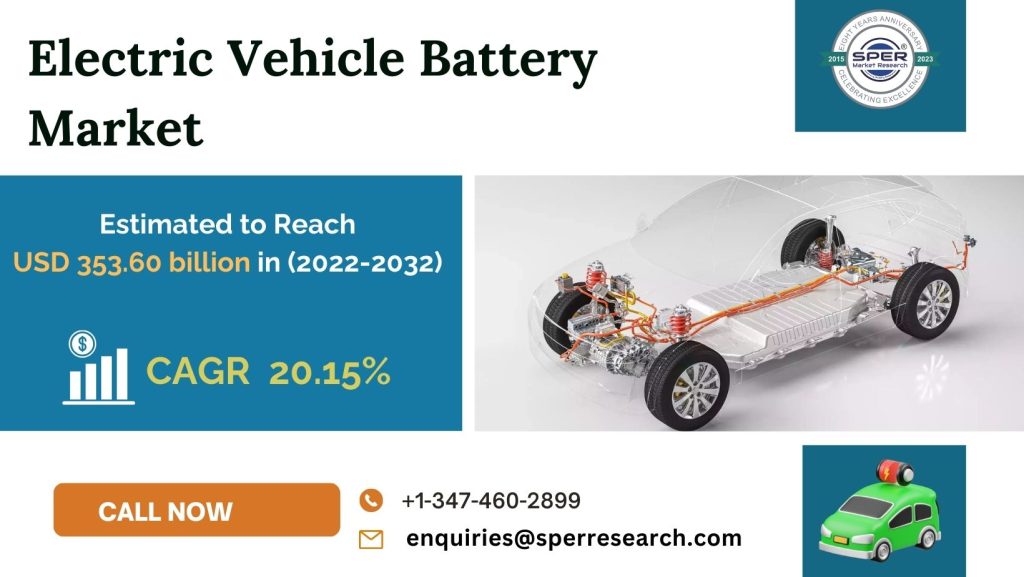E-Vehicle Battery Market Growth, Size-Share, Industry Trends, Revenue, Business Challenges, Future Opportunities and Forecast 2032: SPER Market Research

The primary part of an electric vehicle (EV) is the battery. An apparatus that converts chemical energy into electrical energy is a battery. This process is known as electrochemistry. An electrochemical reaction in an electrical circuit is the movement of electrons from one material to another. Often, the battery is designed to meet the needs of the electric car’s motor(s) and charging mechanism. In order to provide the proper voltage for propulsion, blocks of 18–30 parallel cells are linked in series to form a conventional EV battery pack. The development of advanced electric vehicle technology, such as smaller engines and batteries that are expected to cost less and generate less pollution, is now the primary focus of automakers. The most common battery type used in electric car batteries nowadays is the lithium-nickel-manganese-cobalt-oxide (NMC) battery.
According to SPER market research, ‘Electric Vehicle Battery Market Size- By Propulsion, By Battery Type, By Vehicle Type – Regional Outlook Competitive Strategies and Segment Forecast to 2032’ state that the Electric Vehicle Battery Market is predicted to reach USD 353.60 billion by 2032 with a CAGR of 20.15%.
One of the main reasons propelling the market’s expansion is the considerable rise in the global interest in electric cars is growing. To fight climate change and minimise imports of fossil fuels, governments are aggressively encouraging fast electrification, which is increasing the uptake of electric vehicles. Concerns about the environment are also encouraging people to drive more sustainably, which is driving up demand for EVs and expanding the worldwide market for electric car batteries. Additionally, depending on their intended application, EVs employ a variety of battery types, including lithium-ion, lead acid, and nickel-metal hydride. The focus of top automakers on launching long-range, high-capacity EVs is anticipated to propel demand for EV batteries globally.
Seasonal differences in production can cause supply and price swings in the expensive cost of producing EVs which has also led to a major barrier to their widespread adoption. The overall cost of buying electric hatchbacks, crossovers, or SUVs will probably drop to levels equivalent to ICL automobiles due to the predicted decline in battery costs and R&D expenditure, which will increase demand for EVs. Battery costs are heavily influenced by the cathode’s cost due to the comparatively high cost of raw materials such cobalt, nickel, lithium, and magnesium. Because of the expensive manufacturing process, the cost of producing EVs is likewise significantly greater than that of producing ICE cars.
Request For Free Sample Report @ https://www.sperresearch.com/report-store/electric-vehicle-battery-market.aspx?sample=1
In Wuhan, China, the COVID-19 pandemic first appeared towards the end of December 2019. It has already spread over the planet by March 2020, causing a great deal of death and significant financial damage. Numerous industries have been badly disrupted by the epidemic, notably the automobile industry, where major manufacturers have temporarily ceased operations or are working at reduced capacity in compliance with government orders. There is no exception in the energy materials and renewable generating and conversion sector, which includes grid storage, battery-powered electric cars, and personal electronics. This resulted in a sharp drop in sales of electric cars, which has a direct impact on battery sales, particularly for that market segment.
Geographically, with a significant market revenue share, Asia Pacific emerged as the largest market for electric car batteries globally. The key market players of this industry are CATL, Panasonic Holdings Corporation etc.
Global EV Battery Market Segmentation:
The SPER Market Research report seeks to give market dynamics, demand, and supply forecasts for the years up to 2032. This report contains statistics on product type segment growth estimates and forecasts.
By Propulsion Type:Based on the Propulsion Type, Global EV Battery Market is segmented as; Battery Electric Vehicle, Hybrid Electric Vehicle, Plug in Hybrid Electric Vehicle.
By Battery: Based on the Battery Type, Global EV Battery Market is segmented as; Lead Acid Battery, Nickel Metal Hydride Battery, Lithium-ion Battery.
By Vehicle: Based on the Vehicle, Global EV Battery Market is segmented as; Passenger Car, Commercial Vehicle, Two-Wheeler.
By Region: Due to urbanization and increased buying power in various nations, including China, India, Malaysia, and Japan, Asia Pacific is the largest region for EV batteries and is anticipated to have quicker growth throughout the projected period. Demand is further anticipated to increase throughout the projection period due to the government’s emphasis on converting two- and three-wheelers into electric cars. Additionally, consumer awareness of clean energy and the fact that China is the world’s largest producer of electric cars and that India is the top importer of lithium-ion batteries are all expected to boost revenue growth. This report also provides the data for key regional segments of North America, Europe, Asia-Pacific and Rest of the World.
This study also encompasses various drivers and restraining factors of this market for the forecast period. Various growth opportunities are also discussed in the report.
For More Information, refer to below link:-
Electric Vehicle Battery Market Future Outlook
Related Reports:
Follow Us –
LinkedIn | Instagram | Facebook | Twitter
Contact Us:
Sara Lopes, Business Consultant – U.S.A.
SPER Market Research
+1-347-460-2899





